By Elizabeth Fritz
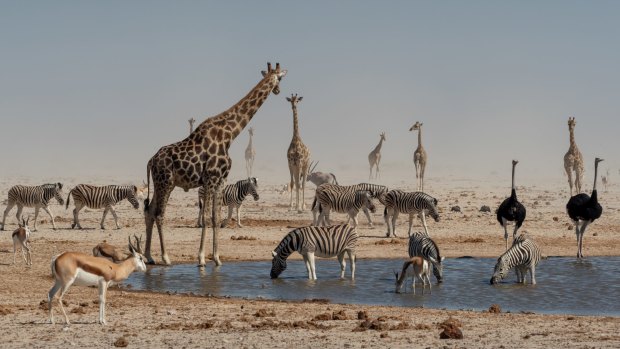
Numerous species gathering at a waterhole at Etosha Pan, Namibia.Credit: Peter Fritz
Quick, turn off the engine!" instructed Mr Fritz with great excitement. "There's a giraffe coming!" By now we'd spent close to two hours quietly sitting next to a water hole in our blisteringly hot, rented Toyota HiLux, completely mesmerised by the miraculous scene unfolding before our eyes.
Herds of zebra had been filing in from every direction, like apparitions through the dusty heat haze. Majestic oryx were present in great numbers as were always-nervous-looking springboks. A lone kudu, several ostriches and even a jackal appeared like ghostly figures on the horizon and braved the scorching conditions to quench their thirst.
And now a giraffe? I silenced the engine while Mr Fritz zoomed in with his camera. "There's actually seven!" he announced with childlike enthusiasm. Suddenly, we felt like the luckiest people alive as we waited in the suffocating heat, sweat trickling into our underpants and sand blasting in through the open windows and whipping our ears.
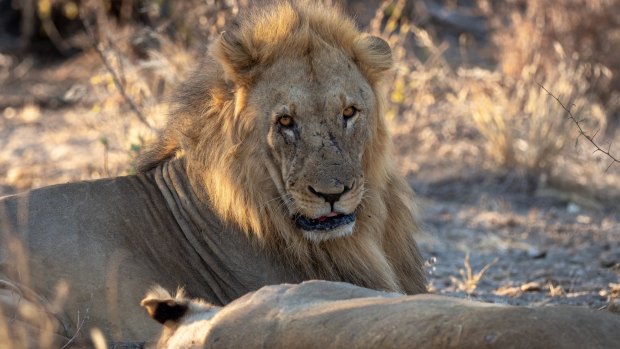
A pair of lions lazing by the road.Credit: Peter Fritz
This unique region in northern Namibia is characterised by a vast, dried-out salt lake known as Etosha Pan (Etosha means "great white place" and it's large enough to be visible from space). In 1851, it was viewed for the first time by European explorers, setting in train a series of turbulent events including an insatiable thirst for big game hunting and the building of a fort by German troops in 1899, all of which had a significant impact on the landscape, its people and its animals.
The original reserve occupied an astounding 100,000 square kilometres, about half the size of Victoria, and extended all the way to the Atlantic coast. Over time, the park's boundaries were reduced, reaching its current 22,000 square kilometres in 1967.
Thanks to conservation efforts, animal populations have increased and Etosha now welcomes thousands of travellers each year. In 2017, more than a million tourists visited Namibia.
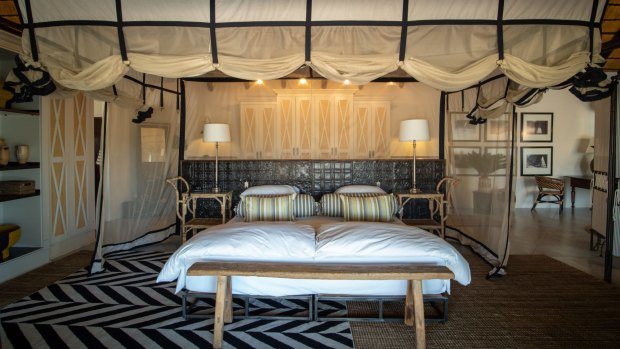
The “African luxe” aesthetic of a Villa Mushara bedroom. Credit: Peter Fritz
But Australians are not that well-represented yet and several times, much to our amusement, we were thought to be Austrian.
Inside the park gates, which are closed at dusk to deter poaching, is where you'll find the reception centres, rest camps and other facilities. Many travellers choose to stay in the chalets, campsites or luxury tents but there are also several upmarket lodges outside the gates if that's more your style.
One of the lodges we chose to stay in is eight kilometres outside the Von Lindequist Gate, on the eastern border, an easy five-hour drive from Windhoek, Namibia's capital.
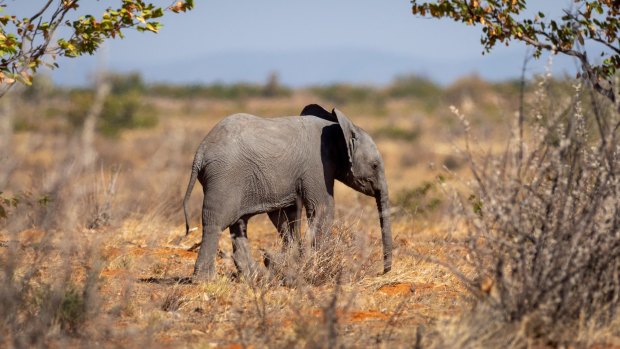
A baby elephant.Credit: Peter Fritz
Villa Mushara, located in the grounds of Mushara Lodge, is a quintessential safari experience – one that even includes an adorable family of warthogs who have taken to grazing on the lawns near the main lodge and the pool.
As Laimi, the delightful supervisor, swung open the enormous timber door to our oversized, thatched-roof villa we were struck by the most sublime mix of textures: art, wood, rattan and metallic accents, even a divine freestanding copper bath. A design aesthetic that is pure African luxe.We enjoyed sundowners of whisky and soda before indulging in a three-course dinner on the terrace. With smiles on our faces we dropped onto our oh-so-romantic netted bed and wondered what animal adventures the following day would bring.
Spotting wildlife is, of course, the most thrilling aspect of a safari holiday. But experiencing unique African-style lodges, chatting to knowledgeable and friendly staff and simply tuning into a different rhythm are almost as rewarding.
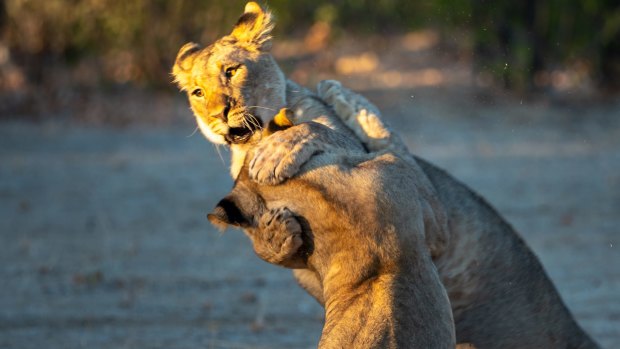
Cubs wrestling in the morning light.Credit: Peter Fritz
Snacking on biltong and dröewors – a thin, dry sausage flavoured with coriander seeds – or feasting on oryx and ostrich, if you choose, all adds to the Africa experience.
And then there's the ever-changing scenery that engages you, from the woodland savannah and grasslands to stands of shimmering mopane trees with their butterfly-shaped leaves.
Muted dusty blues and soft pinks on the horizon and the giant, chalky-white salt pan all add to the visual splendour. Hours of intense scanning for animals in this landscape can also lead to many false and hilarious sightings, such as rocks masquerading as rhinos and leopard-shaped branches.
But whether you choose to drive yourself, as we mostly did, or go with a guide, you can be certain that the corrugated, dusty roads will place you firmly in the moment.
There are, of course, no guarantees in the wildlife-spotting game. But what's so wonderful about Etosha is that you can simply drive to a waterhole and wait. That's how we spotted a rhino, then watched it playfully trot about and threaten a springbok.
We also delighted in families of warthogs, and antelopes such as red hartebeest, eland and black-faced impala, as well as groups of menacing-looking wildebeest. But animals pop up anywhere, anytime, like the pair of lions we stumbled on, lazily napping on the side of the road.
And then one afternoon we almost drove into a herd of elephants. These family-oriented gentle giants can weigh up to seven tonnes and reach a height of four metres. Nothing intimidates quite like an elephant towering over your car looking as if it's sizing you up.
There are rules around elephants. Don't get too close. If you enter their personal space they will let you know about it. It wouldn't get more terrifying than a trumpeting bull elephant charging at your car.
We kept a safe distance, but I was on high alert. "Watch that huge one on your right! He's coming this way!" I warned Mr Fritz with noticeable anxiety in my voice.
He yelled back excitedly, "At the back of the bull, I think there's a baby elephant … I can see its trunk."
I spun around and with a bemused tone responded, "Oh, Mr Fritz, that's not a baby elephant's trunk."
This article appears in Sunday Life magazine within the Sun-Herald and the Sunday Age on sale October 13.
Sign up for the Traveller Deals newsletter
Get exclusive travel deals delivered straight to your inbox. Sign up now.